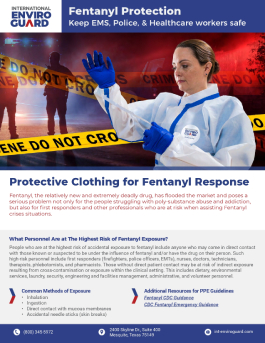We use cookies to make your experience better. To comply with the new e-Privacy directive, we need to ask for your consent to set the cookies. Learn more.
Personal Protective Equipment for Fentanyl Response
What is Fentanyl?
Fentanyl is a powerful opioid, which makes it highly addictive and dangerous to all who come into contact with this substance. This powerful, synthetic drug is similar to morphine and heroin but it’s much more powerful. In fact, it is 80 to 100 times more potent than morphine. According to the National Institute of Environmental Health Sciences (NIH), only 2-3 milligrams of Fentanyl can cause death—that’s comparable to 5-7 grains of salt!
The Fentanyl Crisis
Fentanyl has flooded the market and poses a serious problem not only for those struggling with substance abuse and addition, but also for first responders and other professionals at risk when assisting fentanyl crisis situations.
International Enviroguard has a long track record of assessing protective needs and providing rapid delivery to essential teams after floods, hurricane clean ups, oil spills, and highly contagious infections disease outbreaks.
What is an Opioid?
Opioids are a class of drugs that act as pain relievers. They are naturally derived from the opium in poppy plants or are made in labs by scientists using the same chemical structure. They can be legally prescribed, or illegally purchased. Common examples of legally prescribed opioids include fentanyl, oxycodone, hydrocodone, morphine, codeine, and methadone. Illegal opioids include heroin and illegally produced fentanyl.
What color is Fentanyl and what does it look like?
Synthetic fentanyl powder can take on a variety of colors depending on the additives, and it can also be consumed in a variety of forms. This drug can be white, pink, purple, blue, and even green. Fentanyl can be consumed via lozenges, tablets, patches, injections, and sprays. This can make it hard to quickly identify, which is why appropriate PPE must be worn at all times when working around potent drugs.
Who is Affected by Fentanyl?
In healthcare, people who are at the highest risk for accidental exposure to fentanyl include anyone who may come in direct contact with patients known or suspected to be under the influence of fentanyl and/or have the recreational drug on their person. Personnel at high-risk include first responders (firefighters, police officers, EMTs), nurses, doctors, technicians, crime lab analysts, therapists, phlebotomists, pharmacists, students, and trainees.
However, even people without direct patient contact may be at risk for indirect exposure via cross-contamination and exposure within the clinical setting. This includes dietary, environmental services, laundry, security, engineering and facilities management, administrative, and volunteer personnel.
How Does Fentanyl Exposure Happen?
Common methods of accidental and potentially fatal Fentanyl exposure include:
- Inhalation (breathing it in)
- Ingestion (eating it)
- Direct contact with mucous membranes (touching the eyes, nose, or mouth)
- Absorption through the skin if it is in a liquid state
- Accidental needle sticks (skin breaks)
Additional Resources for PPE Guidelines:
